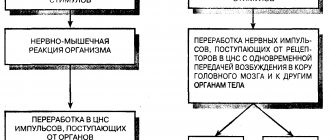The world of human relationships is complex and, unfortunately, does not always bring us joy. There are often moments that cause resentment and bitterness, irritation or disappointment. These are difficult feelings that I would like to get rid of, and a person has unconsciously learned to protect his psyche from excessive overload and negativity. S. Freud was the first to study and describe the mechanisms of psychological defense, determining that one of the most ancient and primitive mechanisms is projection.
Concept and principle of operation
To understand how projection works, you need to imagine the operation of an electronic projector. The principle of its operation is that the broadcast image is transferred to any opposite surface. The same thing happens after a person accumulates negative emotions. She begins to pour them out on those around her.
Difficult experiences include shame and guilt. In order not to feel them, natural defensive reactions of the psyche are triggered. After displaying aggression and hatred towards others, a person does not rid himself of negativity, but passes it on to others. Thanks to this, he does not feel guilty because he believes that others are no better than him.
A defense mechanism, which psychologists call projection, begins to form in any person immediately after birth. It develops under the influence of various prohibitions established by society. During upbringing, ideas about what is good and what is bad are fixed in the mind. At the same time, in the process of growing up, more and more prohibitions appear that are established by society.
The projection mechanism consists of several stages:
- The subject feels discomfort, irritation, shame. They are associated with wrong thoughts, behavior that is forbidden when viewed from the point of view of social rules.
- There is a desire to get rid of any negative emotions. A person begins to take unpleasant sensations beyond the boundaries of his consciousness.
- He begins to transfer his emotions and negativity onto other people in order to get rid of the feeling of shame.
Based on this principle, it can be explained why heavy drinkers blame others for drinking too much. Officials accuse ordinary people of theft to justify their own sins. Husbands who wish to cheat often show outbursts of jealousy towards their wives. There are many such situations, each of them clearly demonstrates the work of projection as a defense of one’s own psyche.
What is the projection effect in psychology
The projection effect is a type of psychological defense in which a person attributes his own qualities, desires, feelings and thoughts to another. A greedy person will think that everyone around him is greedy, a hot-tempered person will see those around him as hot-tempered, and an aggressive person will see others as aggressive. People who are characterized by this defense mechanism are often confident in the dishonesty of others. Although they themselves are usually inclined to do this one way or another. They notice the speck in someone else's eye, but they don't even see the log in their own. What a person suppresses or does not accept in himself, he projects onto others. This does not always apply only to bad personality characteristics. This also works in cases where we suppress our positive traits.
Our projections have no relation to the object to which we transfer them.
We can interpret the same act in different ways. Now, if I myself yelled at the child, then it is the child’s fault, he did not listen and deserved it. And if someone nearby yells at their child, then he is an unbalanced parent.
This protective mechanism is more likely to work in vulnerable and impressionable people.
To one degree or another, each of us faces projections. Often we are irritated in others by the very qualities that we ourselves possess. For example, a new work colleague seems arrogant and domineering to you, but in fact this is our property, realized or carefully suppressed.
Kinds
There are different types of projection in psychology:
- Complementary - manifests itself in the attribution of qualities that are completely opposite to one’s own feelings. For example, this can manifest itself in phrases such as “I am honest, generous, and you are deceitful and greedy.”
- Attributive - a classic projection, when activated, a person begins to attribute his own sins to other people. So he tries to dump the feeling of guilt on the interlocutor so as not to feel it himself.
- Autistic - a person projects his own needs into the outside world. Because of this, any poor person will fixate his attention on money, a friend who has experienced betrayal will look for a catch in new acquaintances.
- Rational - manifests itself when blaming other people after making their own mistakes or showing weakness.
Often different types of projections interact with each other. Typically, such interactions occur with people who are insecure.
Super protection
Under the influence of deep emotions or stress, a person stops perceiving all unpleasant information and hears only good things. This psychological technique is called information selection; it is somewhat similar to the mechanism of denial or avoidance, when an individual does not want to believe what happened and denies it.
The so-called “protective façade” also refers to the “overprotection” mechanism, when a quiet person suddenly begins to behave unusually brazenly and thereby plunges those around him into shock. Devaluation of the threat, as well as personalization of anxiety, are also overprotective techniques. And if in the first case a person pushes away thoughts about the threat looming over him due to the commission of certain actions (for example, smoking - as a consequence the threat of lung cancer), then in the second case, in his worries, which are most often causeless, looking for culprits from outside. Overprotection also includes reinsurance (never fly on airplanes, eat healthy food, etc.), fixation, repression, overconservatism, diflexion (the same as withdrawal), disconnection from reality, depersonalization (when a person disconnect from the main problem, begins to do something insignificant, etc.), “cutting the Gordian knot” (unconscious risk), symbolic or ritual actions (belief in omens), sublimation (revaluation of life values), etc.
By the way, people with a high level of psychological defense resort to completely different techniques, such as optimism, clarity of thought, analysis, a realistic view of things, treating oneself with humor, etc. However, only a real person can treat problems in this way. In psychology, despite the fact that the word “personality” refers to any creature that is endowed with consciousness, speech, creative capabilities, etc., nevertheless, in everyday life, when talking about personality, we mean those people who have willpower and character , are extraordinary and strong people.
Advantages and disadvantages
The protective projection has many disadvantages that can be seen with the naked eye:
- A person hides his negative experiences, emotions, weaknesses under projection, without trying to solve them.
- When defensive reactions are triggered, reality is distorted. Because of this, a person sees only what he wants and does not notice real events.
- Interpersonal conflicts often arise due to the fact that problems are shifted to a partner, relatives, or friends.
- Incorrect assessment of the behavior of others.
Projection advantages:
- Projection helps to cope with internal conflicts that arise due to negative thoughts and emotions. If you do not cope with internal experiences, psychological illnesses may arise - prolonged depression, psychosis, neuroses. To prevent this, projection comes into play, which protects the human psyche.
- Projection plays a big role in empathy. This allows mothers to feel how their child feels in those moments when he does not get what he wants. If projection did not exist, the world would become callous and insensitive.
Projection is a method of psychological defense that protects the human psyche from injury.
If you take into account the disadvantages of this phenomenon, you can competently manage protection so as not to expose loved ones to negative feelings.
Summary about projection
Projection
– a person tends to attribute his feelings, emotions, problems, thoughts to the environment.
Examples. “I’m not angry, it’s everyone around me who’s angry at me.” An anxious person believes that others are too anxious. Kind people believe that everyone around them is kind. So, a person who is angry can ask another “why are you so angry?”
Symbolic meaning of projection : “Instead of you, I see another / myself.
Symbolic image of projection: Cinema screen, mirror.
Verbal indicators : the word “I” is replaced by “you”, “he”, “she”.
Nonverbal indicators of projection : Avoiding eye contact. Gestures. directed at another.
What happens to arousal aimed at achieving contact: The source of arousal is attributed to another.
Pronoun: “it” or “they” instead of “I”.
Therapist's actions: Help the client to discover and accept the rejected parts and his personal experience. Replacing “you”, “he” with “I”. Orientation in the environment by recognizing the client’s usual behavior.
All mechanisms for interrupting contact in Gestalt (fusion, introjection, projection, etc.)
How to determine the use of a mechanism?
Examples of the use of projection as a psychological defense mechanism:
- A young doctor who has little experience begins to worry about his internal problems. These experiences intensify over time and prevent him from sensibly assessing the work situation. For this reason, in the extract about the patient’s psychological state, problems appear that belong to the doctor himself
- Psychologists conducted a study with a group of people suffering from alcohol addiction who were treated in a treatment center. During the treatment course, psychologists showed them three different paintings by the same artist. The first of them depicted several men sitting at a common table with papers in their hands. The second picture showed the same men, but in frozen poses. The third painting showed stones. Participants in the experiment were asked what they saw in three pictures. Everyone answered that these were images of a drinking party, people from whom got drunk and fell under the table. The personal problem of the experiment participants distorted their view of reality. Because of this, they saw their alcoholism reflected in the pictures shown.
From practical examples it is clear that in addition to protecting the psyche, projection can cause many inconveniences.
Psychological defense through surrender
When a person, assessing his achievements in life, feels internal dissatisfaction, he resorts to such a form of defense as capitulation. It can be expressed by gerontolism or puerilism. For example, he can console himself with the fact that he still has everything ahead, or, conversely, blame his age for his failures, saying, if I were young, then everything would be different. By the way, this type also includes intropunity (the opposite of extrapunity), when a person blames himself for everything. This form is mainly used by people with an inferiority complex.
Why is this method of protection dangerous?
Consequences of using projection:
- Distortion of reality.
- The accumulation of problems that are hidden under the projection leads to the development of difficulties in personal life, work activities, and communication with other people.
- After an outburst of negative emotions on others, the feeling of guilt intensifies. There comes temporary relief, which is replaced by new experiences.
To protect yourself from possible dangers, you need to learn to understand how projection works in different situations, try to control your actions and statements.
Other methods of protection
In addition to projection, there are several other methods of psychological defense:
- Denial is a defensive reaction that begins to develop in childhood. Its first manifestations can be noticed when a child breaks a plate, but persistently proves to the mother that it was not he who did it. Denial often occurs in people who do not want to accept a serious diagnosis. Strong psychological pressure from the outside will only strengthen the defense of the psyche, which will lead to a person’s general isolation.
- Repression is a psychological defense mechanism with the help of which pressing problems are forced out of consciousness into the area of the unconscious, but this does not make the problem disappear. It takes root in the psyche, which is why the general condition does not change for the better.
- Introjection is a defense mechanism by which a person immerses himself in the world of his authority. At the same time, you can find out which feelings warm him more, what he lacks.
- Isolation is a mechanism by which a person divides his personality into two parts. He accepts and protects one, denies one and tries to hide it from others.
- Regression is a psychological defense mechanism, when activated, a person moves to a simplified level of functioning.
- Fantasy is a defense mechanism by which the subject creates an unreal reality that cannot happen in real life. This helps to cope with the thirst for your own desires.
- Transferred aggression. It helps not to be offended by your loved one when he, returning from his own affairs in a bad mood, begins to take out aggression on loved ones.
- Reactive education. It appears in people who do not know how to save money. Moreover, the more difficult it is for them to earn a certain amount, the faster they will spend it.
Another psychological defense mechanism is rationalization. It can be seen in the stories that students or schoolchildren write when they are late for class or fail to complete their homework.
Projection is a psychological defense mechanism that develops in any person from birth. It protects the human psyche from the destructive effects of negative emotions, experiences, and grievances. A defensive reaction distorts reality, which prevents people from assessing the situation sensibly.
Projection in psychology: examples from life
Since this defense mechanism occurs frequently, there are many examples around us. Let's learn how to find projections!
Example No. 1 Natalya believes that her husband will cheat on her at any opportunity. She is pathologically jealous of every woman passing by and calls him a “womanizer.” Although her husband never gave her a reason to doubt herself. In fact, she herself is not averse to having an affair on the side, but she will never admit it to herself. Therefore, she returns to this topic again and again every day.
Example No. 2 Kolya was in love with Sveta in his youth. They dated, but then for some reason Sveta left him. Kolya decided that Sveta did this because she did not have a high level of intelligence, which means that all women in the world do not either. When he now meets girls, he knows in advance that they are not distinguished by their sharp minds.
Example No. 3 Ekaterina is 55 years old and has never been married. She loves to scold today's youth for their promiscuity. This happens because she herself has been deprived of relationships with the opposite sex all her life. Catherine is jealous. However, the woman will condemn her lonely friend even more, who also remains an “old maid.”











